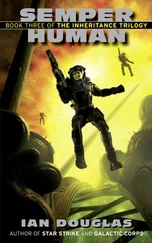“Okay, Marines,” Lieutenant Singer said, “Listen up. We do this by the book, and we’ll come through this alive.”
Well, most of us, I thought. Maybe …
If we were very, very lucky… .
“Remember to steer for the rock end of the facility,” Singer went on. “The doughnut will navigate itself to the main control hab, and that’s where we’ll make the breach. We don’t know what kind of defenses the tangos might have in there, so stay sharp, and keep an eye on your CT2 displays. Got it?”
“Ooh-rah!” a number of the Marines chorused back, their centuries-old battle cry.
I wondered how the CT2W could sort new fear from what was there already.
Oh, I knew how it worked in theory. The Cognitive Technology Threat Warning System has been around in one form or another since the early twenty-first century. It picks up P300 brainwaves, which are linked to stimulus evaluation and categorization. Back in the 2020s, this was handled by a smart helmet equipped with scalp sensors. For the last century or so, though, it’s been a program running within a soldier’s cerebral implants. The idea is that we can detect a threat subconsciously, well before it actually manifests as a bad guy with a weapon. It sounds wild, using brainwaves to detect subconsciously perceived threats, but tests show Marines pick up about 47 percent of hidden threats with just their eyes or standard optics … compared with 90-plus percent when they’re running a CT2WS.
“Two minutes.”
“Weapons check,” Staff Sergeant Thomason called. “Lock and load!”
I looked at my own weapon, a Mk. 30 Sunbeam-Sony carbine packing a half-megajoule-pulse in a mass of just four kilos. My sidearm was the usual Browning Five, a stubby, mag-accelerator handgun that could hurl a five-millimeter bit of steel-jacketed depleted uranium at a thousand meters per second. Both weapons were charged, hot-linked to my in-head, and safed.
There’s an old myth that says Navy Hospital Corpsmen don’t go into combat armed. That might have been true once, back when the Geneva Convention dictated the rules for civilized warfare. Unfortunately, any nonhuman bad guys we happened to run into weren’t going to be signatories of those documents … and that was definitely true of the human hijackers we were facing now.
“Hey, Gunny,” Sergeant Woznowiec called. “Any intel yet on how many tangos are waiting for us in there?”
“Negative on that, Woz,” Hancock replied. “When I know, you’ll know.”
“Comm silence,” Singer warned. “Stay the hell off the TC.”
Shit. The tactical channel was shielded and short-ranged. There was no way the bad guys could be listening in. Singer was an asshole … worse, a wannabe asshole fresh out of the Naval Academy.
“One minute.”
“We’re getting a warn-off from Zeta station,” Thomason said. “They’ve seen us.”
There was a lot of traffic in low-Earth orbit. The idea had been to slip in close like an innocent cargo tug. Unfortunately, that deception couldn’t provide us with cover indefinitely. The station’s radar would have been tracking us for long minutes already, and collision avoidance alarms might be going off over there already.
“Twenty seconds,” Thomason added. “Dropping the backrests.”
Those rigid boards behind our backs, shaped to fit our armor backpacks and meta tanks with snug precision, were grown from the canister’s internal nanomatrix, just like made-to-order chairs and tables grown from the floor. At an electronic command from our AI, they dissolved back into the deck, leaving each of us moving with the Katy. I felt my boots leaving the deck, just by a few millimeters, as the sexy AI voice sounded off the final countdown.
“Cargo launch in five … four … three … two … one … initiate.”
The Katy fired its forward maneuvering thrusters. From our point of view, the walls of the cargo canister abruptly slid backward, and the entire platoon emerged suddenly into open, empty space. The vast, eye-watering blue and mottled white of Earth filled half of the sky with aching beauty. The sun was squarely at our backs; the sunset terminator stretched along the curve of the horizon ahead.
The Marine version of a KT-54 was called a shotgun Katy for a reason. By decelerating sharply, the vessel’s armored human cargo hurtled from the wide-open bow, moving at the same speed as the tug until it slowed. Now it was dropping away behind us, empty, and 2nd Platoon kept moving at a constant velocity toward our objective. For all intents and purposes, it was as though we’d just been fired into space like a cloud of pellets from an enormous shotgun.
“Platoon, shift to Formation One,” Singer ordered. “Deploy!”
Our Mk. 10 suits were locked into standard M287 dorsal jumpjet packs. On the ground they let us bound across the landscape in twenty-meter jumps. In open space, they turned each of us, in effect, into a small, independent spacecraft. They were fueled by cryo-stabilized N-He64, an exotic fuel commonly called meta that was far denser in terms of available energy than conventional propellants. The thrusters were controlled by our in-head software; I told mine that I wanted to move into Formation One, and my backpack gave a gentle kick to my right.
The Marine formation was opening up, creating a more dispersed target in case the bad guys started taking shots at us. The shift also cleared the way for our doughnut, which was accelerating now on its own, moving up the center of the formation and into the distance ahead, homing on the bright star of Capricorn Zeta.
My jumpjet pack bumped again, halting my outward drift. Around me, the Marines appeared to be unmoving, hanging motionless in space relative to me and to one another. The surface of the Earth, however, drifted past at a steady pace. We were coming up on the west coast of Baja at the moment; north, I saw the cloudless ocher expanses of the Arizona and New Mexico deserts; southeast, bright stars strung in a vertical line stretching up into the sky flashed with a steady wink-wink-wink that marked the space elevator over Cayambe, a thread otherwise made invisible by distance.
And moment by moment, the Zeta facility grew brighter, taking on shape and form—an awkward collection of cylinders dazzling in the sunlight, connected at one end to a black rock a kilometer across.
We’d been thoroughly briefed on the Zeta situation, of course, complete with in-head downloads showing every detail of the five-hundred-meter facility. Asteroid mining was a particular target of the neo-Ludd movement, of course, so Zeta had offered them some highly visible propaganda for the watching global netizens back on Earth.
That small and wrinkled-looking nickel-iron asteroid, listed as Atun 3840, was only a kilometer across, but it contained an estimated 2 trillion dollars’ worth of platinum, 2 trillion in iron and nickel, and perhaps 1.5 trillion dollars’ worth of cobalt … a total of more than 5 trillion dollars of commercial metals.
The first asteroid mining had commenced early in the twenty-first century, with robots that extracted precious metals on-site and slingshotted them back to circum-Earth space where they were captured. There, one-ton slugs of solar-purified metal were injected with inert gas, molded into lightweight glider wings, sheathed in cheap, refractory heat shielding, and sent on down for recovery in the ocean … a cheap and highly efficient system still used to this day. The very first of Humankind’s trillionaires made their fortunes with the various space mining start-ups of the 2020s, paid for our expansion out into the Solar System, helped us survive the return of the Ice Age, and ultimately funded the first starships.
Читать дальше












